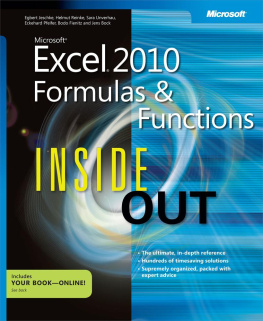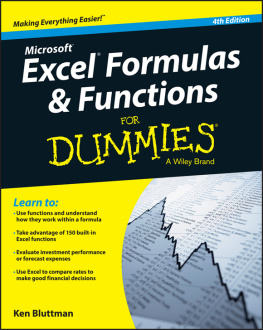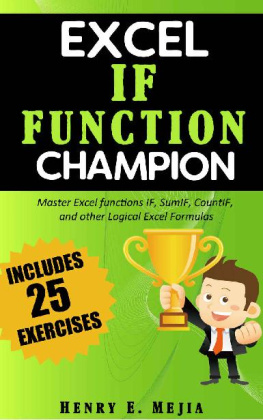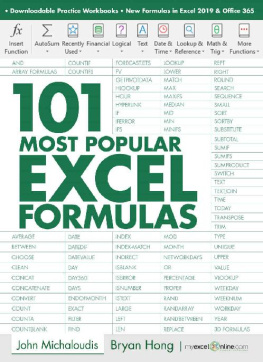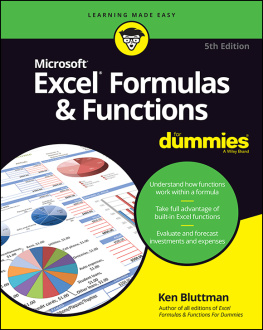Function and Formula Excel 2016
Function and Formula Excel 2016
Ali Akbar

2016
Copyright 2016 by Kanzul Ilmi.
All rights reserved. This book or any portion thereof may not be reproduced or used in any manner whatsoever without the express written permission of the publisher except for the use of brief quotations in a book review or scholarly journal.
Author: Ali Akbar
Editor: Zico Pratama Putra
Cover Designer: Zico Pratama Putra
First Printing: 2016
ISBN 978-1-329-91775-0
Kanzul Ilmi Press
Victoria Rd
London, UK
Ordering Information:
Special discounts are available on quantity purchases by corporations, associations, educators, and others. For details, contact the publisher at the above listed address.
U.S. trade bookstores and wholesalers: Please contact Kanzul Ilmi Press email zico.pratama@gmail.com.
Chapter 1. Date & Time
Date & Time are very important things in Excel, Excel supports many functions related to date & time. This chapter describes many date & time-related functions in excel.
Note: My computer display date on DDMMYYYY format, so I hope you dont get confused when reading the content of this chapter.
.Date
Date function returns serial number that represents date in date-time form. This function needs year, month and day parameters to form the date.
For example, you can see pic below:

Pic1.1 Datefunction
If the cell formatted as General before the function entered, the cell will return regular date. But if the cell formatted as Number, it will return 42038 which is the serial date from date parameter inserted.
You can define Number format by clicking Home > Number.

Pic1.2Choosing format for Number
DATE function is very important when you need to process a separated-year-month-day values and you want to make single date value from that values.
See table below for date function examples:
Formula | Description |
=DATE(A2,B2,C2) | Serial date for data taken from year A2, month B2, and day C2 as argument fro DATE function . |
=DATE(YEAR(TODAY()),12,31) | Serial date for the last day of this year. |
=DATE(LEFT(A4,4),MID(A4,5,2), RIGHT(A4,2)) | Formula to convert string texts in A4 (for example : 2015 1125) that represents "YYYYMMDD" format to serial date. |
1.2 DateValue
Datevalue will return serial date value based on data entered. But the difference with the previous Date function is the data parameter inserted in text form, between quote sign ()

Pic1.3DateValue function
Excel saves date value as serial number to make date calculation easier. For example january 1st 1900 will have date serial number = and january 2008 will have date serial number , becaues its , days after january 1st 1900.
See table below for DATEVALUE function examples:
Formula | Description |
=DATEVALUE("8/22/201 ") | Serial value from date inserted as text |
=DATEVALUE("22-MAY-201 ") | Serial value from date inserted as text. |
=DATEVALUE("201 /02/23") | Serial value from date inserted as text. |
=DATEVALUE("5-JUL") | Serial value from date inserted as text. |
=DATEVALUE(A2 & "/" & A3 & "/" & A4) | Serial v alue from date inserted as text by combining texts from cell A2, A3 and A4. |
1.3 Day
Day function will return the day-th value from a serial-date value. You can enter the serial date as string or number.
For example if you insert 42653 as an argument , this will return day value 10, because its the th day in the month .
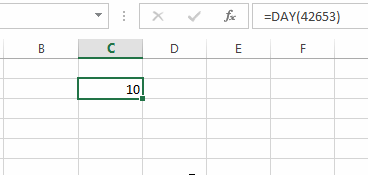
Pic1.4 DAYreturns the day value from serial date
1.4 Days
Days function is for calculating the distance between two dates. You can enter the two date arguments as regular date or serial date. You have to enter the end_date first , and then the start_date /initial_date.

Pic1.5Entering argument for end_dateand start_date
If you click Enter, the distance between end_date and start_date will be calculated and displayed.

Pic1.6Dinstance betweenend_dateandstart_date
See table below for Days function examples:
Formula | Description |
=DAYS("3/15/1 ","2/1/1 ") | Finding the distance between end_date (3/15/15 ) and start_date (2/1/15 ). If you want to enter the date directly in the function, you have to enclose it with quotation mark. |
=DAYS(A2,A3) | Finding the distance between end_date in cell A2 and start_date in A3 . |
1.5 Days 360
Days360 returns distance between two dates, end_date, and start_date with assumption that a year have days, or in other words, its assumed that
a year = months x 30 days .
Arguments needed in Days360 function are start_date, and end_date.

Pic1.7 Days360function
In Days360 function, you can have methods as argument:
Method | Definintion |
FALSE or empty | U.S. (NASD) , if start_date is the last day in a month, it will be the 30 th day. If end_date is the last day in a month, and start_date before the 30th day in that month, then end_date will be the 1 st day in the following month, or end_date will be the 30th day from the same month. |
TRUE | Europe method, start_date and end_date on the 31 st will be considered as 30 th in the same month. |
1.6 Edate
Edate function returns the date before/after initial date after a month_interval. The parameter for this function are start_date for initial date, and before/after month_interval. Before month_interval will have negative value.
For example this function edate below will count 2 months after 1/10/15 (my computer using DDMMYY time format):
Next page




